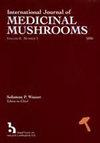Mosquitocidal Susceptibility and Non-Target Effects of Tricholoma equestre (L.) P. Kumm. On the Immature Stages of Aedes aegypti (Linnaeus in Hasselquist), Anopheles stephensi Liston and Culex quinquefasciatus Say
IF 1.4
4区 生物学
Q4 MYCOLOGY
International journal of medicinal mushrooms
Pub Date : 2024-01-01
DOI:10.1615/intjmedmushrooms.2024052514
引用次数: 0
Abstract
The worldwide scientific community is well aware that mosquitoes are the sole agents responsible for transmitting various dreadful diseases and critical illnesses caused by vector-borne pathogens. The primary objective of this current research was to evaluate the effectiveness of methanol extract from Tricholoma equestre (L.) P. Kumm. in controlling the early life stages of Culex quinquefasciatus Say, Anopheles stephensi Liston, and Aedes aegypti (Linnaeus in Hasselquist). mosquitoes. The larvae, pupae and eggs of these mosquitoes were exposed to four different concentrations (62.5 to 500 ppm). After 120 hours of treatment, the methanol extract of T. equestre exhibited ovicidal activity ranging from 66% to 80% against the eggs of the treated mosquitoes. It also demonstrated promising larvicidal and pupicidal activity with LC50 values of 216-300 and 230-309 ppm against the early life stages of all three mosquito species. Extensive toxicity studies revealed that the methanol extract from T. equestre had no harmful effects on non-target organisms. The Suitability Index (SI) or Predator Safety Factor (PSF) indicated that the methanol extract did not harm Poecilia reticulata Peters 1859, (predatory fish), Gambusia affinis S. F. Baird & Girard 1853, Dragonfly nymph and Diplonychus indicus Venkatesan & Rao 1871 (water-bug). Gas chromatography-mass spectrometry (GCMS) analysis identified key compounds, including 3-Butenenitrile, 2-Methyl-(25.319%); 1-Butanol, 2-Nitro-(18.87%) and Oxalic Acid, Heptyl Propyl Ester (21.82%) which may be responsible for the observed activity. Furthermore, the formulation based on the methanol extract demonstrated similar effectiveness against all treTricholoma equestre (L.) P. Kumm.对埃及伊蚊(Linnaeus in Hasselquist)、史蒂芬按蚊(Anopheles stephensi Liston)和库蚊(Culex quinquefasciatus Say)未成熟阶段的影响
全世界的科学界都清楚,蚊子是由病媒传播的病原体引起的各种可怕疾病和危重病的唯一传播媒介。目前这项研究的主要目的是评估从 Tricholoma equestre (L.) P. Kumm.中提取的甲醇提取物在控制库蚊(Culex quinquefasciatus Say)、按蚊(Anopheles stephensi Liston)和埃及伊蚊(Aedes aegypti (Linnaeus in Hasselquist))早期生命阶段的有效性。这些蚊子的幼虫、蛹和卵暴露于四种不同浓度(百万分之 62.5 至 500)的甲烷中。经过 120 小时的处理后,T. equestre 的甲醇提取物对处理过的蚊子卵具有 66% 至 80% 的杀卵活性。它还显示出良好的杀幼虫和杀蛹活性,对三种蚊子早期生命阶段的半数致死浓度分别为 216-300 ppm 和 230-309 ppm。广泛的毒性研究表明,T. equestre 的甲醇提取物对非目标生物没有有害影响。适宜指数(SI)或捕食者安全系数(PSF)表明,甲醇提取物不会伤害 Poecilia reticulata Peters 1859(捕食鱼类)、Gambusia affinis S. F. Baird & Girard 1853、蜻蜓若虫和 Diplonychus indicus Venkatesan & Rao 1871(水蝽类)。气相色谱-质谱(GCMS)分析确定了关键化合物,包括 3-丁烯腈,2-甲基-(25.319%);1-丁醇,2-硝基-(18.87%)和草酸,庚基丙酯(21.82%),这些化合物可能是产生所观察到的活性的原因。此外,以甲醇提取物为基础的制剂对所有三尖杉属植物都具有类似的功效。
本文章由计算机程序翻译,如有差异,请以英文原文为准。
求助全文
约1分钟内获得全文
求助全文
来源期刊
CiteScore
2.60
自引率
16.70%
发文量
91
审稿时长
6-12 weeks
期刊介绍:
The rapid growth of interest in medicinal mushrooms research is matched by the large number of disparate groups that currently publish in a wide range of publications. The International Journal of Medicinal Mushrooms is the one source of information that will draw together all aspects of this exciting and expanding field - a source that will keep you up to date with the latest issues and practice. The International Journal of Medicinal Mushrooms published original research articles and critical reviews on a broad range of subjects pertaining to medicinal mushrooms, including systematics, nomenclature, taxonomy, morphology, medicinal value, biotechnology, and much more.

 求助内容:
求助内容: 应助结果提醒方式:
应助结果提醒方式:


